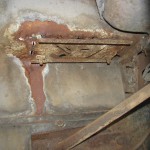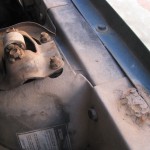How to: Buy a Mustang – Spot rust on a Classis Mustang
Common Rust on Classic Mustangs
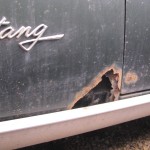 R-U-S-T is definitely a four letter word when looking at classic Mustangs for sale. It’s a cancer that affects almost every vintage car to some extent, is very expensive to fix and sometimes hard to spot. Underestimating the cost and amount of rust is a common newbie mistake, but also can catch seasoned enthusiasts. It can turn a cheap Mustang project car into a money pit quicker then you can whip out your checkbook. It’s almost always to your advantage to opt for the more expensive car without rust then the bargain car in need of severe rust repair.
R-U-S-T is definitely a four letter word when looking at classic Mustangs for sale. It’s a cancer that affects almost every vintage car to some extent, is very expensive to fix and sometimes hard to spot. Underestimating the cost and amount of rust is a common newbie mistake, but also can catch seasoned enthusiasts. It can turn a cheap Mustang project car into a money pit quicker then you can whip out your checkbook. It’s almost always to your advantage to opt for the more expensive car without rust then the bargain car in need of severe rust repair.
Many elements factor into how rusty a car is. What part of the country is it in? Has it been driven in the snow where they salt the roads? Has it been garage kept or left to soak out in the driveway? In addition to these generic factors vintage Mustangs have their own specific problem areas for rust.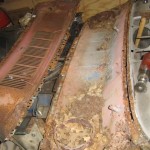
- Cowl Vents – The cowl is the vented area just behind the hood at the base of the windshield. The design allows for fresh air intake for the heater, but also allows water and leaves to collect and just sit. Check the carpet near the firewall for any moisture or a mildew smell. Take a garden hose and run water down the windshield so it goes into the cowl openings. Then poke your head under the firewall from the inside and look for any leaks. If this area is rusted it can be very expensive to fix properly. Everything under the dash needs to be removed, the rusted metal cut out and new patch panels welded in and sealed up. If the used Mustang you’re looking at has a cowl leak, factor into the price some professional help to be required to fix it properly.
- Floor Boards – If you can, pull the carpet up. Cowl leaks or heater core leaks can cause small amounts of moisture to soak into the carpet where it sits and attacks the floor boards. Also check the floor pans from underneath the car. Heavy undercoating can make rust hard to spot, but tap on them and listen for solid metal. Check for repair work while you’re under there. A proper floor board repair will be welded in, not screwed or riveted, which is really just a quick fix by the previous owner.
- Front Fenders – The lower rear corner of the front fenders is another typical rust problem
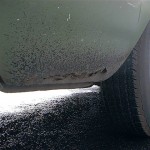 area. Dirt and snow gets thrown up there constantly and rust finds a good home.
area. Dirt and snow gets thrown up there constantly and rust finds a good home. - Rear Quarters – The rear quarter panels are supposed to have drain holes so that any water getting in through a bad trunk seal will work it’s way out. Unfortunately over the years these drains get plugged up and this area can get filled with dirt, leaves and moisture. To inspect pull the trunk mat our and lift the floor extenders (if they’re even still there) Use a flashlight to peer into the bottom of each quarter panel. Heavy rust will be obvious, but also look carefully for bubbles in the paint. Thick undercoating can sometimes make this hard.
- Wheel Wells – The curve of the wheel wells creates a lip on the inside that holds mud and snow. Bubbles in the paint are a sure sign, but also use a mirror or take off the tires to see back behind on top of the lip.
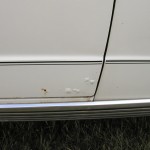
- Door Bottoms – Like the rear quarters, the doors have factory drain holes at the bottom that can get plugged. Once the door window weather stripping gets old and cracks rain can easily get inside the door skin. Again, look for bubbles in the paint on the exterior. Also lay on your back on the ground under the open door to look at the seam where the skin is crimped on to the door shell. Any rust at the seam is sure to mean much more rust hiding inside.
- Shock Towers – Pop the hood and check the inner fenders near where the shocks mount. This area is sometimes rusted all the way through even though the area around is perfectly good sheet metal.
- Battery – While you’re inspecting the engine bay check the area around the battery. Years of battery acid can eat off the paint and make this area very susceptible to rust.
